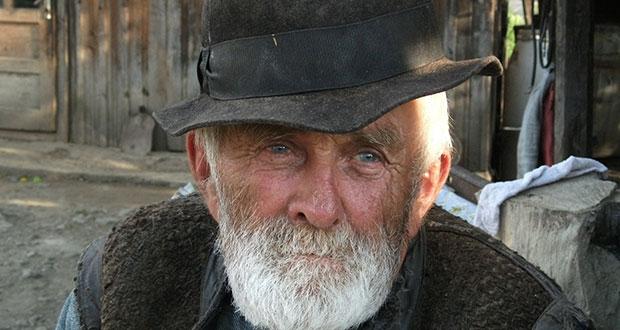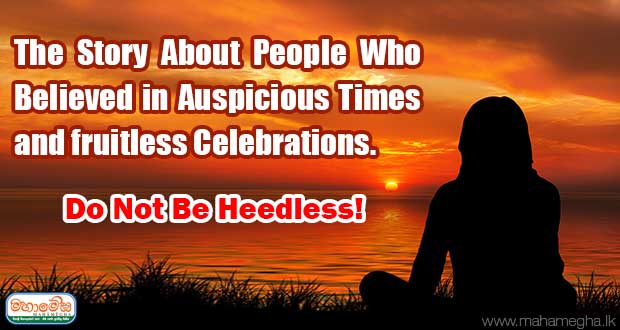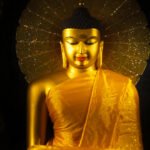On a beautiful full moon day in the month of July, 2606 years ago, the Lord Buddha Siddhartha Gautama revealed, for first time, to the world what he realized with the attainment of supreme enlightenment. He realized the reason for birth, reason for aging, sickness and death. He realized that beings are in a never ending cycle of births and deaths called ‘sansara’ and that birth takes place not only in the human world but also in animal world, hell world, ghost world and the world of devas. This means we had been born before, countless times in different worlds and had aged and experienced all what we are experiencing now and died, countless times. Lord Buddha realized a path to freedom from this cycle of rebirth. This realization, this knowledge is called the ‘Four Noble Truths.’ This realization did not come easily. He had to perfect His life for four hundred thousand eons of countless eons. He perfected his life as a ‘Buddha-to-be’ (Bodhisatta) to gain the qualities needed to become a Lord Buddha. And until a Lord Buddha realizes the Four Noble Truths, they are not known to the world. ‘Not known’ does not mean they do not exist. The noble truths exist but no one knows about it. The unknown truth is; we are being born for countless times in different worlds, we age, we die, we lose loved ones; all this happens due to a reason; once that reason is removed this cycle ends; and there is a way to remove the reason.
What a Lord Buddha does is he realizes that such a phenomenon is happening and he shed light on it so that others also can understand and realize it. Therefore, we need to understand that the revelation of the Four Noble Truths happens only during the time of a Lord Buddha. And there has been only seven Samma-Sambuddhas for the past hundred eons. The magnificence, the greatness, the nobleness of the four noble truths should be understood in that way. So what are the four truths? What did the Lord Buddha explain in his first sermon?
First noble truth is ‘Dukkhan ariya saccan’ – the noble truth of suffering as it is commonly translated. To learn the exact meaning of the word ‘dukkha’ we need to look at what the Lord Buddha explained as ‘Dukkhan ariya saccan’.
The Lord Buddha explained, “jātipi dukkhā, jarāpi dukkhā, vyādipi dukkho, maraṇampi dukkhaṁ, soka parideva dukkha domanassupāyāsāpi dukkhā, appiyehi sampayogo dukkho, piyehi vippayogo dukkho, yamp’icchaṁ na labhati tampi dukkhaṁ, saŋkhittena pañcupādānakkhandhā dukkhā”
‘jātipi dukkhā’ means birth is dukkha. But it is difficult for us to understand this. How can birth be associated with dukkha or suffering? Birth is considered a joyful thing, which is why we celebrate birth. So, to understand how birth becomes a suffering, we need to learn what ‘birth’ is.
The Lord Buddha explained four places where birth happens;
• inside a mother’s womb – in human world and animal world;
• inside an egg – mainly in animal world;
• in wet environment – animal world.
• spontaneously – among gods, in hell and in the ghost world and rarely among humans as well.
It is clear from this, that birth is not an occurrence limited to human world. It happens in many other worlds. Animal world is a world we can see and that co-exists with the human world. There are uncountable varieties of animals in the world starting from tiny creatures such as ants to elephants, from pets to farm animals and to wild creatures living in dense forests, from creatures living in the water to those who roam the skies. These are all births. Now think about the joy we associate with birth? Can you apply that to these births as well? Plus, it is not the case that animals are always born as animals and humans as humans. In fact beings shift from one world to another according to the kamma they have accumulated. Further, Lord Buddha also stated that the appearance of the aggregates- khandhānaṁ pātubhāvo, and acquiring of the sense faculties – āyatanānaṁ paṭilābho, as birth.
‘jarāpi dukkhā’ meaning aging is dukkha. We all experience pains and sufferings associated with aging especially when we lose our hearing or sight or agility. Lord Buddha explained aging as decaying, losing teeth, graying hair, skin wrinkling, the diminishing of the life-span, the wearing out of the sense-organs.
‘vyādipi dukkho’ means sickness is suffering. As Buddha clearly stated the human body is a nest for diseases and there is no end to the suffering that can manifest in a body prone to sickness.
‘maraṇampi dukkhaṁ’, means death is dukkha. This is something we are all aware of and struggle to come to terms with. There is nothing pleasant about death.
‘soka – parideva dukkha domanassupāyāsāpi dukkhā’
‘Soka’ means sorrow or grief. So many things in our lives give rise to sorrow. We grieve when some calamity hits us. When overwhelmed with grief and sorrow we are unable to think clearly or act properly. It has the power to burn our insides, squash our heart and take control of our actions. We all have experienced sorrow and suffered from grief.
‘parideva’ means lamentation. It is the crying, the wailing, the act of crying, the act of wailing. When some kind of an ill and unpleasant thing comes our way we cry and wail and become mentally distraught. For example, when a loved one dies, we lament, we become nostalgic and every happy moment we had spent with the one who died arouses lamentation. Consolation does not seem possible when this happens. We all have suffered this form of suffering in our lives.
What is ‘dukkha?’ here the Buddha explains unbearable physical suffering as dukkha. It is bodily suffering, bodily unpleasantness, the painful and unpleasant feeling produced by bodily contact. We normally do not think about our body as a place that generate pain and suffering, at least until we get very sick or very old and our body gives up on us. But even when we are sick we think about the cause; virus or bacteria, or we blame people whom we think are responsible for spreading the disease or not finding cures. We do not think and we do not know to think that our body, which is a host for all sorts of sicknesses, is part of the problem. Our body is fragile, it ages and does not stay the same. The sun can make it suffer, the rain, the cold, the fire can make it suffer or destroy this body completely. We are blind to the suffering the body causes and we praise this body, spend a lot of money pampering it, deluded by the gratification of the body we fails to see the suffering it brings forth.
‘domanassa’ means misery or mental suffering. All of us have experienced emotions such as stress, intimidation, anxiety, anger and fear. When these emotions take over our mind we become their puppets. They overcome our mental ability to act rationally even for a short period. This is a suffering that exists in our lives.
‘upāyāsā’ means the painful state of mind caused by tribulation and distress due to various kinds of loss and misfortune one faces in life. And that is another form of suffering that exists in our lives.
‘appiyehi sampayogo dukkho’ means the suffering of being associated with what one dislike. There are times when we come into contact with disagreeable forms, sounds, smells, tastes, tangibles and thoughts that makes us unhappy. Also there are instances when we have to put up with people we dislike, people who cause us harm and wish for our downfall. Suffering caused in this manner is ‘appiyehi sampayogo dukkho’
‘piyehi vippayogo dukkho’ means the suffering caused by having to disassociate with what you like and desire. If we have to part with loved ones such as father, mother, brother, sister, friends, colleagues, friends or relatives we feel unhappy. Likewise if we have to disassociate with forms, sounds, smells, tastes, tangibles and thoughts that we find to be pleasing we feel sad and unhappy. This is what Buddha pointed out as suffering caused by having to disassociate with what you like and desire.
‘yamp’icchaṁ na labhati tampi dukkhaṁ’ means the pain that comes when we do not get what we want. What is that we desire but cannot get? We want not to be born again, but we are born. Haven’t we all seen people overcome with grief, wail “I do not want to be born again!” Though they wish for freedom from birth, it does not happen.
Not only birth, the Lord Buddha explains many other things that we wish for, we desire but can never gain by wishing and mere desiring. They are; not age; not be sick; not die; not be subjected to sorrow, lamentation, suffering, misery, and despair. Regardless of how much we want these we never get them. This state of despair, caused by not getting what one desires is another facet of suffering that frequents our life.
‘saŋkhittena pañcupādānakkhandhā dukkhā’ means, in brief, the five aggregates of clinging or the five aggregates that are subject to grasping cause suffering. What are the five aggregates? These are the aggregate of form, the aggregate of feeling, the aggregate of perception, the aggregate of mental (volitional) formations, the aggregate of consciousness. The Lord Buddha said, in a nut shell “the five aggregates of clinging” is “suffering”.
So, if we take a moment and think about the suffering: ‘dukkha’, it becomes clear that they are inevitable facts of life. No one can deny their existence. And no one can escape from aging or getting sick or from dying or from losing loved ones or from grief. Thus it is an eternal ‘truth’ of life, not a made up story. Whether you like it or not, whether you want it or not, it happens. Even if the supreme Buddha pointed it out or not, it happens. What a Samma-sambuddha does is realize this truth about life and reveal it to a world that does not know of its existence. We are all subjected to this suffering, we experience this everyday but we are just unaware of it. Therefore suffering is a ‘truth’ that coexists with our lives.
This truth is first realized by a Buddha, the noblest person ever to exist. And for a Buddha to realize it he has to perfect his life for an uncountable number of eons, as said above. And when a supreme Buddha explains this, expounds this truth, others see it, and that makes them noble men and noble women. All these facts make it a ‘noble truth’. There are four noble truths.
The most compassionate Buddha did not just say that there is this suffering and there’s nothing you can do about it. That would have been so unfair. What Buddha did was he realized the ‘cause’ of suffering. He realized it happens due to a reason. And He also realized that if the ‘reason’ or ‘cause’ is eliminated the ‘suffering’ will end. And He realized and expounded the ‘way to be free from suffering’. These are the four noble truths.
Today, we discussed about the first noble truth, ‘Dukkhan ariya saccan’. We will discuss the Noble Truth of the arising (cause) of suffering; dukkhasamudayaṁ ariyasaccaṁ, the Noble Truth of the cessation of suffering; dukkhanirodhaṁ ariyasaccaṁ, and the Noble Truth of the Path leading to the cessation of suffering; dukkhanirodhagāminī paṭipadā ariyasaccaṁ in future articles.
By Prajapathi Jayawardena














Recent Comments